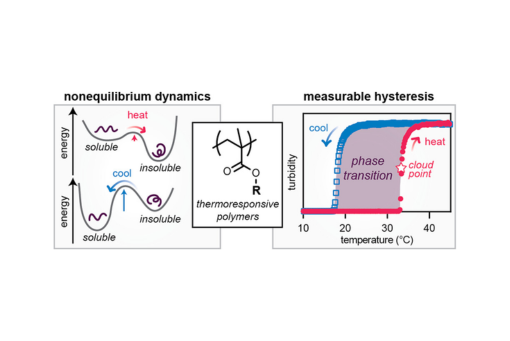Investigating Fundamental Principles of Nonequilibrium Assembly Using Temperature-Sensitive Copolymers
Abstract
Both natural biomaterials and synthetic materials benefit from complex energy landscapes that provide the foundation for structure–function relationships and environmental sensitivity. Understanding these nonequilibrium dynamics is important for the development of design principles to harness this behavior. Using a model system of poly(ethylene glycol) methacrylate-based thermoresponsive lower critical solution temperature (LCST) copolymers, we explored the impact of composition and stimulus path on nonequilibrium thermal hysteretic behavior. Through turbidimetry analysis of nonsuperimposable heat–cool cycles, we observe that LCST copolymers show clear hysteresis that varies as a function of pendent side chain length and hydrophobicity. Hysteresis is further impacted by the temperature ramp rate, as insoluble states can be kinetically trapped under optimized temperature protocols. This systematic study brings to light fundamental principles that can enable the harnessing of out-of-equilibrium effects in synthetic soft materials.
Citation
Investigating Fundamental Principles of Nonequilibrium Assembly Using Temperature-Sensitive Copolymers
Supraja S. Chittari, Allie C. Obermeyer, and Abigail S. Knight
Journal of the American Chemical Society 2023 145 (11), 6554-6561
DOI: 10.1021/jacs.3c00883


